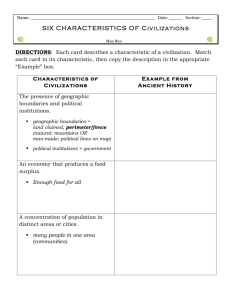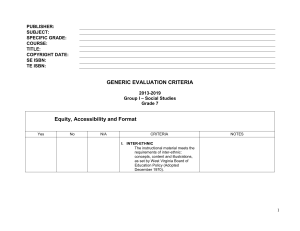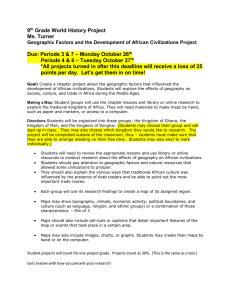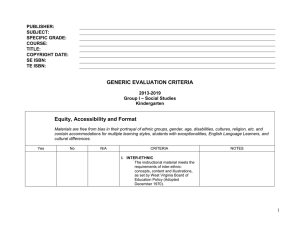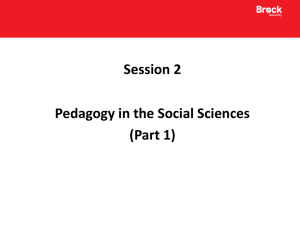GENERIC EVALUATION CRITERIA
advertisement
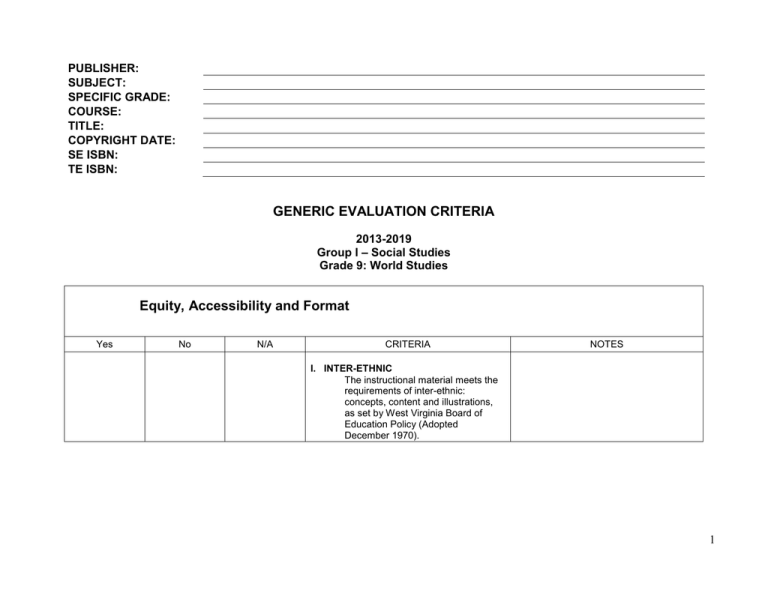
PUBLISHER: SUBJECT: SPECIFIC GRADE: COURSE: TITLE: COPYRIGHT DATE: SE ISBN: TE ISBN: GENERIC EVALUATION CRITERIA 2013-2019 Group I – Social Studies Grade 9: World Studies Equity, Accessibility and Format Yes No N/A CRITERIA NOTES I. INTER-ETHNIC The instructional material meets the requirements of inter-ethnic: concepts, content and illustrations, as set by West Virginia Board of Education Policy (Adopted December 1970). 1 II. EQUAL OPPORTUNITY The instructional material meets the requirements of equal opportunity: concept, content, illustration, heritage, roles contributions, experiences and achievements of males and females in American and other cultures, as set by West Virginia Board of Education Policy (Adopted May 1975). III. FORMAT This resource is available as an option for adoption in an interactive electronic format. GENERAL EVALUATION CRITERIA 2013-2019 Group I – Social Studies Grade 9: World Studies INSTRUCTIONAL MATERIALS ADOPTION: 21st CENTURY LEARNING EVALUATION CRITERIA The general evaluation criteria apply to each grade level and are to be evaluated for each grade level unless otherwise specified. These criteria consist of information critical to the development of all grade levels. In reading the general evaluation criteria and subsequent specific grade level criteria, e.g. means “examples of” and i.e. means that “each of” those items must be addressed. Eighty percent of the general and eighty percent of the specific criteria must be met with I (In-depth) or A (Adequate) in order to be recommended. 2 (Vendor/Publisher) SPECIFIC LOCATION OF CONTENT WITHIN PRODUCT (IMR Committee) Responses I=In-depth A=Adequate M=Minimal N=Nonexistent I A M N In addition to alignment of Content Standards and Objectives (CSOs), materials must also clearly connect to Learning for the 21st Century which includes opportunities for students to develop: A. Next Generation Skills: Thinking and Problem-Solving Skills Social Studies Content: 1. is presented in a way that deepens student understanding through meaningful and challenging inquiry-based learning that builds on prior knowledge and promotes social science connections (e.g., the importance of geography in historical events, the importance of economics in geography, the importance of past history in civic decision making); 2. engages in complex historical analysis that promotes the development of mental perspectives, thoughtful well-framed questions and thoughtful judgment applicable to students’ own lives and future situations; and 3. promotes local and global connections past and present in realworld, authentic relationships that encourage the consideration of human choice and natural catastrophic events on historic outcomes. Information and Communication Skills/Social Studies For student mastery of content standards and objectives, the instructional materials will include multiple strategies that provide students with the opportunity to: 3 4. locate existing social studies content information, especially primary source documents, to interpret meaning and then create original communication; 5. make informed choices; and 6. interact with outside resources through opportunities for local and global collaboration in a variety of safe venues. Personal and Workplace Productivity Skills For student mastery of content standards and objectives, the instructional materials will provide students with the opportunity to: 7. conduct research, validate sources and report ethically on findings; 8. identify, evaluate and apply appropriate technology tools for a variety of purposes; 9. engage in self-directed inquiry 10. work collaboratively; and 11. practice time-management and project management skills in problem based learning situations. B. Developmentally Appropriate Instructional Resources and Strategies For student mastery of content standards and objectives: 1. Content is structured to ensure all students meet grade‐specific expectations as they develop content knowledge and literacy skills aligned to college and career readiness expectations. 2. Instructional resource includes suggestions for appropriate scaffolding, emphasizes the importance of vocabulary acquisition, provides opportunities to engage in high interest, age‐appropriate activities that mirror real‐life situations, and make cross‐curricular, global connections. 4 3. Instructional material provides opportunities for students to link prior knowledge to new information to construct their own viable mental maps and deepen understanding of the connections of world historical events, geographic regions, economies and geo-politics. 4. Students are provided with opportunities to use maps, graphs, globes, media, and technology sources to acquire and apply new information (e.g., global information systems). 5. Instructional material offers opportunities for students to sequence time, events, social, economic and political influences on a society in chronological order. 6. Instructional material provides opportunities for students to investigate issues that are interconnected (e.g., colonialism, poverty, human rights, environment, energy, safety, immigration, conflict) to solve complex problems that can change at varied entry points suggesting the possibility of multiple solutions. . 7. Instructional resources include guiding questions and essential questions to aid students develop social awareness and a deeper understanding of civic, economic, geographic and historic principles. 8. Resources for intervention and enrichment to allow for personalized learning are provided. 9. Materials provide an electronic resource for students to access for updates of global information in real time. C. Life Skills For student mastery of content standards and objectives, the instructional materials will provide students with the opportunity to: 1. develop a deeper understanding of Civic Literacy (civic engagement, e.g., volunteerism, voting, running for office, influencing and monitoring policy) and to develop civic dispositions. 2. practice Financial Literacy skills, (personal finance, entrepreneurship, business finance, and local, national and global economics). 5 3. develop Global Awareness (global competency in research, communication, presentation, action). D. Assessment 1. To ensure a balanced assessment, the instructional material will provide tools for a balanced approach to assessment including both formative and summative assessments in multiple formats (e.g., rubrics, document based questions (DBQs), performance-based measures, open-ended questioning, portfolio evaluation, and multimedia simulations) that not only guide instruction but also identify student mastery of content. E. Organization, Presentation and Format 1. Information is organized logically and presented clearly using multiple methods and modes for delivering instruction that motivate and increase literacy as students engage in high interest, authentic activities. 2. The use of media enhances instruction and learning. 3. The instructional resource includes an electronic file of the student edition provided on an electronic data storage device (e.g., CD, DVD, USB drive, etc.) and through a link on the publisher’s server, both of which are accessible by a net book or similar device that is internetenabled and can open standard file formats. 6 SPECIFIC EVALUATION CRITERIA 2013-2019 Group I – Social Studies Grade 9: World Studies Ninth Grade World Studies engages students in the study of development and evolution of the historic, economic, geographic, political, and social structure of the cultural regions of the world from the dawn of civilization to the Twentieth Century. Special attention is given to the formation and evolution of societies into complex political and economic systems. Students are engaged in critical thinking and problem-solving skills, using maps, spreadsheets, charts, graphs, text, and other data from a variety of credible sources. Students synthesize the information to predict events and anticipate outcomes as history evolves through the ages. The West Virginia Next Generation Standards include the Next Generation Content Standards and Objectives and 21st Century Learning Skills and Technology Tools. All West Virginia teachers are responsible for classroom instruction that integrates learning skills, technology tools and content standards and objectives. Civics Standard Civics addresses both citizenship and political systems. Citizenship education prepares students to be informed, active and effective citizens who accept their responsibilities, understand their privileges and rights and participate actively in society and government. To be successful participants in society, students must understand how to build social capital (a network of social relationships) that encourages reciprocity and trust, two characteristics of civic virtue and good citizenship. Students must be able to research issues, form reasoned opinions, support their positions and engage in the political process. Students exercise tolerance and empathy, respect the rights of others, and share a concern for the common good while acting responsibly with the interests of the larger community in mind. Students must learn and practice intellectual and participatory skills essential for an involved citizenry. To develop these skills, the curriculum must extend beyond the school to include experiences in the workplace and service in the community. While studying political systems, students develop global awareness and study the foundations of various world governments and the strategies they employ to achieve their goals. With respect to the United States, students learn the underlying principles of representative democracy, the constitutional separation of powers and the rule of law. The students learn the origins and meaning of the principles, ideals and core democratic values expressed in the foundational documents of the United States. Students recognize the need for authority, government and the rights and responsibilities of citizens. Economics Standard Economics analyzes the production, allocation, distribution and use of resources. The economic principles include an understanding of scarcity and choice, productivity, markets and prices, supply and demand, competition, role of government, international trade factors and consumer decisions in a global economy. Understanding economic principles, whole economies and the interactions between different types of economies helps students comprehend the exchange of information, capital and products across the globe. Learners investigate economic principles and their application to historical situations. Learners will work cooperatively and individually to analyze how basic economic principles affect their daily lives. Students become financially responsible by examining the consequences of and practicing personal financial decision-making. Geography Standard Geography encompasses physical and human systems and the interactions between them on local and global scales. People interact with the natural world in culturally distinct ways to produce unique places, which change over time. New technologies and perspectives of geography provide students with an understanding of the world, and the ability to evaluate information in spatial terms. The geography standard stresses the world in which we live and the role of the 7 U.S. in the global community. Students use geographic perspectives and technology to interpret culture, environment and the connection between them. Students collaborate with one another and work individually using geographic skills and tools to ask geographic questions based on the five themes of geography (location, place, human-environmental interaction, movement and regions), acquire the necessary information, organize and analyze the information and respond to those geographic questions. Students examine the varying ways in which people interact with their environments and appreciate the diversity and similarities of cultures and places created by those interactions. Literacy Standard The Literacy Standards for History/Social Studies lay out a vision of what it means to be literate in social studies. The skills and understanding students are expected to demonstrate in both reading and writing have a wide applicability outside the classroom or workplace. Reading requires an appreciation of the norms and conventions of social studies, such as the kinds of evidence used in history; an understanding of domain-specific words and phrases; an attention to precise details; and the capacity to evaluate intricate arguments, synthesize complex information, and follow detailed descriptions of events and concepts in social studies. In writing students must take task, purpose, and audience into careful consideration, choosing words, information, structures, and formats deliberately. They have to become adept at gathering information, evaluating sources, and citing material accurately, reporting finding from their research and analysis of sources in a clear and cogent manner. Students who meet these standards demonstrate the reasoning and use of evidence that is essential to both private and responsible citizenship in a democratic society. History Standard History organizes events and phenomena in terms of when they occurred and examines where, how and why they took place. Students study how individuals and societies have changed and interacted over time. They organize events through chronologies and evaluate cause-and-effect relationships among them. Students analyze how individuals, groups and nations have shaped cultural heritages. They gather historical data, examine, analyze and interpret this data, and present their results in a clear, critical manner. Students study origins and evolutions of culture hearths, settlements, civilizations, states, nations, nation-states, governments and economic developments. Through history, students understand the identity and origins of their families, communities, state and nation. Through history, students recognize the influence of world events on the development of the United States and they evaluate the influence of the United States on the world. Understanding the past helps students prepare for today and the events of the future. 8 For student mastery of content standards and objectives, the instructional materials will provide students with the opportunity to (Vendor/Publisher) SPECIFIC LOCATION OF CONTENT WITHIN PRODUCT IMR Committee Responses I=In-depth A=Adequate M=Minimal N=Nonexistent I A M N A. Civics 1. describe the roles of citizens and their responsibilities (e.g., prehistoric societies; river civilizations, classical civilizations, feudal systems, developing nation states and neo-feudal systems). 2. analyze and connect the status, roles, and responsibilities of free men, women, children, slaves and foreigners across time in various civilizations. 3. research and categorize multiple world aid organizations and assess the importance of global volunteerism as a 21st century citizen (e.g., Amnesty International, Doctors Without Borders, Human Rights Campaign, International Red Cross, Invisible Children, Peace Corps, etc.). 4. analyze and evaluate various ways of organizing systems of government in order to illustrate the continuity and change in the role of government over time (e.g., Hammurabi’s Code, the Twelve Tables of Rome, Justinian Code, Magna Carta, English Bill of Rights, Articles of Confederation and the United States Constitution). 5. examine conflicts and resolutions between groups throughout history and use past outcomes to hypothesize the outcomes of modern conflicts. 6. compare and contrast political ideologies in order to analyze the evolving role of government in world affairs prior the year 1900 (e.g., democracies, republics, dictatorships, various types of monarchies, oligarchies, theocracies and parliamentary systems). 7. explain how individuals and organizations use nonviolent protests, boycotts, riots and other measures as tools in the struggle for civil rights and freedom. B. Economics 9 1. define scarcity and demonstrate the role of opportunity costs in decision making. 2. examine and illustrate the trade patterns (e.g., resource allocation, mercantilism and other economic systems) of regions of the world across time and explain their significance to the evolution of global economics. 3. analyze the importance of family, labor specialization, and regional commerce in the development of global trade systems. 4. identify types of exchange systems (e.g., barter, money) and the role forms of currency play in acquiring goods and services. 5. examine the costs of government policies in relation to the rise and fall of civilizations (e.g., Roman Empire, the Crusades and Imperialism). C. Geography 1. use different types of maps and geographic tools to analyze features on Earth to investigate and solve geographic questions. 2. explain how altering the environment has brought prosperity to some places and created environmental dilemmas for others. 3. apply geography skills to help investigate issues and justify possible resolutions involving people, places and environments. 4. explain how migration of people and movement of goods and ideas can enrich cultures, but also create tensions. 5. explain how the uneven distribution of resources in the world can lead to conflict, competition, or cooperation among nations, regions, and cultural groups. 6. use maps, charts, and graphs to analyze the world to account for consequences of human/environment interaction, and to depict the geographic implications of world events. 7. use latitude, longitude, Prime Meridian and the Equator to describe locations. D. History Demonstrate an understanding of prehistory, the concept of change over time and the emergence of civilization. 1. analyze the interaction of early humans with their environment and evaluate their decisions (e.g., hunting, migration, shelter, food and 10 clothing). 2. detail and predict the causes and effects of the Agricultural Revolution. Demonstrate an understanding of ancient river civilizations and the ways in which early civilizations evolve. 1. compare and contrast the causes and effects of the rise and decline of ancient river valley civilizations. 2. investigate and detail the various components of culture and civilization including customs, norms, values, and traditions, political systems, economic systems, religious beliefs and philosophies in ancient river civilizations. Demonstrate an understanding of classical civilizations and the influence of those civilizations across time and space. 1. compare and contrast the causes and effects of the rise and decline of classical civilizations. 2. analyze the impact of the religion on classical civilizations, including rise and growth of Christianity, Hinduism and the effects of its beliefs and practices on daily life, changes that occurred as a result of Buddhist teachings, and the influence of a variety of religions (e.g., Judaism and Zoroastrianism) on culture and politics. 3. examine and explain the impact and lasting effects of classical philosophy (e.g., Socrates, Plato, Aristotle, Confucianism, Daoism and Legalism) including effects at the point of origin as well as its effects on the world throughout history. Demonstrate an understanding of Middle Age societies and the influence of those societies on the history of the world in areas of social, political and economic change. 1. Investigate and explain the influence of the Byzantine Empire, including the role the Empire played in preserving Hellenistic (Greek) learning. 2. outline the origins and expansion of Islam, and the changing role of women in the modern world. 3. summarize the functions of feudalism and manorialism in Europe, China, and Japan (including the creation of nation-states) as feudal institutions helped monarchies to centralize power. 4. identify and evaluate the individual, political, religious and economic roles in medieval society. 5. analyze the social, political, and economic upheaval and recovery that occurred in Europe during the Middle Ages, including the plague and the subsequent population decline, the predominance of religion and the impact of the crusades. 6. summarize the economic, geographic, and social influences of African, trans-Saharan trade including education and the growth of 11 cities. 7. examine and assess the effects of warfare on society during the middle ages. Demonstrate an understanding of the changes in society because of the Renaissance, Reformation, Age of Exploration, and the Enlightenment. 1. compare the impacts of the Renaissance on life in Europe (e.g., Humanism, art, literature, music and architecture). 2. analyze the religious reformations and their effects on theology, politics and economics. 3. summarize the origins and contributions of the scientific revolution. 4. explain how European needs/wants for foreign products contributed to the Age of Exploration. 5. explain the ways that Enlightenment ideas spread through Europe and their effect on society (e.g., John Locke, Voltaire, Jean-Jacques Rousseau and Baron de Montesquieu.) Demonstrate an understanding of the global political environment of the sixteenth through the nineteenth centuries. 1. explain the long-term effects of political changes because the emergence of strong monarchial governments. 2. describe the Agricultural and Industrial revolutions and determine their impact on the evolution of society. 3. analyze the causes and effects of political revolutions and determine their impact on the formation of governments and on the citizens of a society (e.g., French, Italian, German and Latin America.). 4. illustrate the significant political, commercial, and cultural changes that took place in China. 5. compare the political actions of European, Asian, and African nations in the era of imperial expansion. 6. assess the impact of colonization on both the mother countries and their colonies. 7. explain the causes and effects of political, social, and economic transformation in Europe in the nineteenth century, including the significance of nationalism, the impact of industrialization for different countries and the effects of democratization. E. Literacy: Reading 1. Key Ideas and Details cite specific textual evidence to support analysis of primary and 12 secondary sources, attending to such features as the date and origin of the information. determine the central ideas or information of a primary or secondary source; provide an accurate summary of how key events or ideas develop over the course of the text. analyze in detail a series of events described in a text; determine whether earlier events caused later ones or simply preceded them. 2. Craft and Structure determine the meaning of words and phrases as they are used in a text, including vocabulary describing political, social, or economic aspects of history/social studies. analyze how a text uses structure to emphasize key points or advance an explanation or analysis. compare the point of view of two or more authors for how they treat the same or similar topics, including which details they include and emphasize in their respective accounts. 3. Integration of Knowledge and Ideas integrate quantitative or technical analysis (e.g., charts and research data) with qualitative analysis in print or digital text. assess the extent to which the reasoning and evidence in a text support the author’s claims. compare and contrast treatments of the same topic in several primary and secondary sources. 4. Range of Reading and Level of Text Complexity read and comprehend history/social studies texts at or above grade level text complexity band independently and proficiently. F. Literacy: Writing 1. Text Types and Purposes - write arguments focused on disciplinespecific content. Introduce precise claim(s), distinguish the claim(s) from alternate or opposing claims and create an organization that establishes clear relationships among the claim(s), counterclaims, reasons and evidence. Develop claim(s) and counterclaims fairly, supplying data and evidence for each while pointing out the strengths and limitations of both claim(s) and counterclaims in a discipline-appropriate form and in a manner that anticipates the audience’s knowledge 13 level and concerns. Use words, phrases and clauses to link the major sections of the text, create cohesion, and clarify the relationships between claim(s) and reasons, between reasons and evidence and between claim(s) and counterclaims. Establish and maintain a formal style and objective tone while attending to the norms and conventions of the discipline in which they are writing. Provide a concluding statement or section that follows from or supports the argument presented. 2. Text Types and Purposes - write informative/explanatory texts, including the narration of historical events, scientific procedures/ experiments, or technical processes. Introduce a topic and organize ideas, concepts, and information to make important connections and distinctions; include formatting (e.g., headings), graphics (e.g. figures, tables) and multimedia when useful to aiding comprehension. Develop the topic with well-chosen, relevant and sufficient facts, extended definitions, concrete details, quotations, or other information and examples appropriate to the audience’s knowledge of the topic. Use varied transitions and sentence structures to link the major sections of the text, create cohesion and clarify the relationships among ideas and concepts. Use precise language and domain-specific vocabulary to manage the complexity of the topic and convey a style appropriate to the discipline and context as well as to the expertise of likely readers. Establish and maintain a formal style and objective tone while attending to the norms and conventions of the discipline in which they are writing. Provide a concluding statement or section that follows from and supports the information or explanation presented (e.g., articulating implications or the significance of the topic). 3. Production and Distribution of Writing produce clear and coherent writing in which the development, organization, and style are appropriate to task, purpose and audience. develop and strengthen writing as needed by planning, revising, editing, rewriting, or trying a new approach, focusing on addressing what is most significant for a specific purpose and 14 audience. use technology, including the Internet, to produce, publish and update individual or shared writing products, taking advantage of technology’s capacity to link to other information and to display information flexibly and dynamically. 4. Research to Build and Present Knowledge conduct short as well as more sustained research projects to answer a question (including a self-generated question) or solve a problem and narrow or broaden the inquiry when appropriate; synthesize multiple sources on the subject, demonstrating understanding of the subject under investigation. gather relevant information from multiple authoritative print and digital sources, using advanced searches effectively; assess the usefulness of each source in answering the research question and integrate information into the text selectively to maintain the flow of ideas, avoiding plagiarism and following a standard format for citation. draw evidence from informational texts to support analysis, reflection, and research. 5. Range of Writing write routinely over extended time frames (time for reflection and revision) and shorter time frames (a single sitting or a day or two) for a range of discipline-specific tasks, purposes, and audiences. 15
